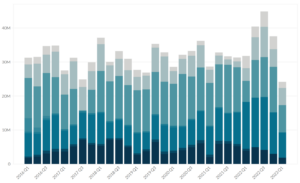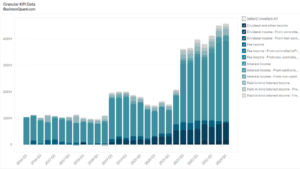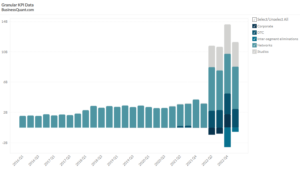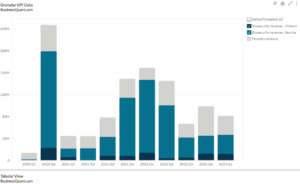
SoFi’s Revenue Breakdown by Business Vertical (2020-2023)
Exclusive Data
You need the Pro Plan to access KPI data
- Full access to the platform
- KPI data & segment financials on US stocks
- Financial data on thousands of stocks
- Download data in xlsx and csv formats
Pro Plan
$49 per month*
60% discount ends in:
.
About
More information
Subscribe to Pro or Enterprise plans to unlock this feature.
Contact the Analyst
Subscribe to Pro or Enterprise plans to unlock this feature.
Become a smarter investor today.
Access KPIs & Segment Financials on US stocks
This statistic highlights SoFi’s Revenue Breakdown by Business Vertical, split across Non-interest income and Interest income, reported on a quarterly basis from Q2 2020 onwards.
SoFi’s Revenue Breakdown by Business Vertical
SoFi’s Revenue Breakdown by Business Vertical increased from $282.37 million in Q3 2020 to $323.09 million in Q3 2021, marking a rise of 14.42% on a year-on-year basis. It decreased almost by 24% as compared to $424.76 million in Q2 2021. SoFi Technologies’ revenue is bifurcated into the following business verticals:
| Revenue Breakdown by Business Vertical | Q3 2020 | Q2 2021 | Q3 2021 | Contribution in Q3 2021 |
| Non-interest income | $243.47 | $396.66 | $301.87 | 97% |
| Interest income | $38.90 | $28.09 | $21.22 | 3% |
| Total | $282.37 | $424.76 | $323.09 | 100% |
(All figures are in millions, except percentages)
Non-interest income
Non-interest income primarily consists of:
- Changes in the fair value of loans held on their consolidated balance sheet.
- Gains on loans sold via securitization or full loan sales.
- the income they receive from their loan servicing activities, as well as the assumption of servicing rights from third parties.
- Profits from loan securitization or full loan sales.
- Revenue from Contracts with Customers, which mostly related to their Technology Platform fees, was reported under ASC 606, Revenue from Contracts with Customers.
- Gains and losses on derivatives, as well as agreements to repay student loans.
- Investments in AFS debt instruments have realized gains and losses.
When they create a loan, they typically anticipate selling it for more than its par value, resulting in positive loan origination and sales performance. Furthermore, recognized servicing assets at the time of a loan sale are included in non-interest income — loan origination and sales. Noninterest income — servicing in their consolidated statements of operations and comprehensive income is affected by the subsequent fair value measurement of their servicing assets, as well as the initial and ongoing evaluation of servicing rights assumed from third parties (loss).
When they originate a loan, they generally expect that they will sell the loan for more than its par value, which will result in positive loan origination and sales results. Non-interest revenue — loan origination and sales also include recognized servicing assets when a loan is sold. The subsequent measurement of their servicing assets at fair value, as well as the initial and ongoing measurement of servicing rights, assumed from third parties, impact noninterest income — servicing in their consolidated statements of operations and comprehensive income (loss).
The gain or loss on sale is reported within noninterest income — loan origination and sales when they sell a loan into a securitization trust that qualifies for genuine sale accounting. Their revenue is split between their Financial Services and Technology Platform segments and has increased as a result of their acquisition of Galileo in 2020.
The major component of 97% of the company’s revenue was made up of Non-interest income. SoFi Technologies revenue owing to the Non-interest income increased from $243.47 million in Q3 2020 to $301.87 million in Q3 2021, indicating a rise of 23.98% on a year-on-year basis.
Interest income
Loan origination volume, prevailing interest rates on the loans they issue, and the length of time they keep loans on their consolidated balance sheet are the main drivers of interest revenue. Interest income from securitizations is generated via securitization-related investments in bonds and residual interest positions, which are required by securitization risk retention requirements.
Interest earned on AFS debt instruments, as well as amortization of premiums and discounts, and other basic changes linked with the investments, are included in other interest income. Additionally, they collect interest on surplus corporate cash balances as well as SoFi Money member accounts. Interest revenue from related parties came from notes extended to Apex and one of their stockholders, and it was not essential to their operations.
Interest income, amounting to $38.90 million in Q3 2020 decreased to $21.22 million in Q3 2021 by 45.44% on a year-on-year basis.
About the Company
SoFi Technologies, Inc. (now known as SoFi and the parent company of Social Finance, Inc.) is a California-based online personal finance company. SoFi is a San Francisco-based financial services firm that provides mobile and desktop apps for student loan refinancing, mortgages, personal loans, credit cards, investing, and banking.
SoFi was founded in 2011 by four students, Mike Cagney, Dan Macklin, James Finnigan, and Ian Brady. The creators of SoFi hoped that by providing more affordable options for students taking on debt to fund their education, they would be able to assist more people. A $2 million Stanford experiment served as the company’s first loan programme.
Did you like SoFi’s Revenue Breakdown by Business Vertical statistic?
Access more such KPI data points and segment financials on thousands of US stocks, with Business Quant.
You can get started here.
More data on US Stocks

Our Plans
Always know what you’ll pay. No hidden costs or surprises.
- Annual
- Monthly
60% discount until this Sunday
Pro
For serious investing
-
Company KPI data Access segment financials, non-GAAP metrics and KPI data from presentations and filings. Examples include financials by segment / region / product category, AT&T's broadband subscriber trends, Tesla's deliveries by model and lots more.
-
Stock research tools Features include : stock screener, stock comparison, industry financials, stock warnings, advanced charting tools, timeseries tables, scatter charts, financial statements, stock reports, SEC filings, stock ratings, institutional and insider ownership data. There are 200+ financial items and ratios on thousands of US stocks.
-
Industry data & tools Access premium operating data on 40+ industries. Examples include market share, smartphone shipments by vendor, subscribers by wireless carrier, historical gold production. There are 20,000+ such statistics.
Enterprise
For tailored workflows
-
All of Pro plan Get unfettered access to all our dashboards and dossiers.
-
Custom built features Get tailored dashboards built specially for you , based on your set of requirements, to simplify your research workflow.
-
Admin billing Back-end documentation support and multi-seat licensing.
* Billed annually, local taxes extra.
60% discount on Annual plan
Pro
For serious investing
-
Company KPI data Access segment financials, non-GAAP metrics and KPI data from presentations and filings. Examples include financials by segment / region / product category, AT&T's broadband subscriber trends, Tesla's deliveries by model and lots more.
-
Stock research tools Features include : stock screener, stock comparison, industry financials, stock warnings, advanced charting tools, timeseries tables, scatter charts, financial statements, stock reports, SEC filings, stock ratings, institutional and insider ownership data. There are 200+ financial items and ratios on thousands of US stocks.
-
Industry data & tools Access premium operating data on 40+ industries. Examples include market share, smartphone shipments by vendor, subscribers by wireless carrier, historical gold production. There are 20,000+ such statistics.
Enterprise
For tailored workflows
-
All of Pro plan Get unfettered access to all our features.
-
Custom built features Get tailored dashboards built specially for you , based on your set of requirements, to simplify your research workflow.
-
Admin billing Back-end documentation support and multi-seat licensing.
* Local taxes extra.






